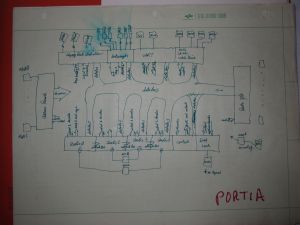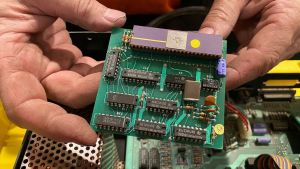Difference between revisions of "Portia"
(Created page with "Portia is the original version of Paula, both the creation of Glenn Keller. Portia's sound capabilities were 4 channels of 8-bit audio which could be attached and modulated us...") |
|||
| (5 intermediate revisions by the same user not shown) | |||
| Line 1: | Line 1: | ||
| − | Portia is the original version of Paula, both the creation of Glenn Keller. Portia's sound capabilities were 4 channels of 8-bit audio which could be attached and modulated using either AM or FM. Other functions included a serial port (UART), disk controller, interrupts and an interface for analog game controllers employing potentiometers (pots) such as paddles. The disk controller was originally designed for reading Apple ][ disks, using GCR encoding. MFM encoding was incorporated once it was decided the machine would have an IBM compatible drive. Bit 8 - “DISK FAST”, located in register ADKCON can enable either MFM or GCR. | + | [[File:TIMINGBOOK-1L.jpg|thumb|center]] |
| + | |||
| + | Portia, also known as 4703 is the original version of Paula, both the creation of [[Glenn Keller]]. Portia's sound capabilities were 4 channels of 8-bit audio which could be attached and modulated using either AM or FM. Other functions included a serial port (UART), disk controller, interrupts and an interface for analog game controllers employing potentiometers (pots) such as paddles. The disk controller was originally designed for reading Apple ][ disks, using GCR encoding. MFM encoding was incorporated once it was decided the machine would have an IBM compatible drive. Bit 8 - “DISK FAST”, located in register ADKCON can enable either MFM or GCR. | ||
| + | |||
| + | [[File:Portia-tower.jpg|thumb|center]] | ||
Some development systems have a riser board, or tower for Portia which includes a disk separator circuit. Further improvements to the circuitry were made on the breadboards and the chip was renamed Paula. | Some development systems have a riser board, or tower for Portia which includes a disk separator circuit. Further improvements to the circuitry were made on the breadboards and the chip was renamed Paula. | ||
Glenn recalls, “Paula had a much better digital PLL and far better audio than Portia. Paula had at least one spin. The major change in the part was the Portia -> Paula transition, which already included the better audio and MFM disk controller capability. There was at least one Paula spin to tune the audio DAC transistor sizes to get better DNL, and I did a full static timing check of Paula at some point and fixed a few things. The most memorable ones were the pots port and the UART carry chain path. Who would have thunk the pots port could have a timing problem? This exercise taught me the incredible power of static timing checks.” | Glenn recalls, “Paula had a much better digital PLL and far better audio than Portia. Paula had at least one spin. The major change in the part was the Portia -> Paula transition, which already included the better audio and MFM disk controller capability. There was at least one Paula spin to tune the audio DAC transistor sizes to get better DNL, and I did a full static timing check of Paula at some point and fixed a few things. The most memorable ones were the pots port and the UART carry chain path. Who would have thunk the pots port could have a timing problem? This exercise taught me the incredible power of static timing checks.” | ||
| + | |||
| + | == References == | ||
| + | |||
| + | # Peck, Rob - ''Amiga Hardware Manual'' - Commodore-Amiga, 1984-85 | ||
| + | # Glenn Keller | ||
| + | # Burns, Bob. [https://groups.google.com/g/comp.sys.amiga.tech/c/5IJ1RhT5500/m/otGFnq8CPGYJ ''Do all 3.5 inch drives use the same encoding''] - Usenet - Nov 15, 1988 | ||
Latest revision as of 20:28, 23 June 2023
Portia, also known as 4703 is the original version of Paula, both the creation of Glenn Keller. Portia's sound capabilities were 4 channels of 8-bit audio which could be attached and modulated using either AM or FM. Other functions included a serial port (UART), disk controller, interrupts and an interface for analog game controllers employing potentiometers (pots) such as paddles. The disk controller was originally designed for reading Apple ][ disks, using GCR encoding. MFM encoding was incorporated once it was decided the machine would have an IBM compatible drive. Bit 8 - “DISK FAST”, located in register ADKCON can enable either MFM or GCR.
Some development systems have a riser board, or tower for Portia which includes a disk separator circuit. Further improvements to the circuitry were made on the breadboards and the chip was renamed Paula.
Glenn recalls, “Paula had a much better digital PLL and far better audio than Portia. Paula had at least one spin. The major change in the part was the Portia -> Paula transition, which already included the better audio and MFM disk controller capability. There was at least one Paula spin to tune the audio DAC transistor sizes to get better DNL, and I did a full static timing check of Paula at some point and fixed a few things. The most memorable ones were the pots port and the UART carry chain path. Who would have thunk the pots port could have a timing problem? This exercise taught me the incredible power of static timing checks.”
References
- Peck, Rob - Amiga Hardware Manual - Commodore-Amiga, 1984-85
- Glenn Keller
- Burns, Bob. Do all 3.5 inch drives use the same encoding - Usenet - Nov 15, 1988

